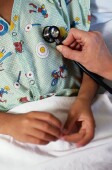Angioplasty No Better Than Drug Treatment in Long Run
Benefit disappears within three years, study finds.
By Ed Edelson
HealthDay Reporter
|
E-mail this article
Subscribe to news
Printer friendly version
|

(SOURCES: William S. Weintraub, M.D., chief, cardiology, Christiana Health Care System, Newark, Del.; Eric D. Peterson, M.D., professor, medicine, Duke Clinical Research Unit, Durham, N.C.; Aug. 14, 2008, New England Journal of Medicine)
WEDNESDAY, Aug. 13 (HealthDay News) -- There are some advantages to artery-opening angioplasty over drug treatment for people with heart disease, but those advantages disappear within three years, according to the latest report on a pivotal study on the subject.
Angioplasty does offer a higher quality of life for months to a couple of years, said study leader Dr. William S. Weintraub, chief of cardiology at the Christiana Health Care System in Delaware.
In the COURAGE trial, the researchers tested angioplasty, with stent implants, against drug treatment for 2,287 people with stable coronary disease. Earlier analysis found improved quality of life for those having the artery-opening procedure that is formally called percutaneous coronary intervention (PCI). The latest report, in the Aug. 14 issue of the New England Journal of Medicine, found that by 36 months, there was no significant difference in health status between the two treatment groups.
"What one can say is that for people with chronic, stable coronary disease, PCI can be deferred," Weintraub said. "They can continue on medication aimed at their specific risk factors -- hypertension, lipid disorders, diabetes -- and should be encouraged to have a good lifestyle, with exercise, smoking cessation and weight control."
A decision to have PCI can depend on how an individual feels, Weintraub said. "If people say, 'My pain is so bad I can't function,' that is one thing," he said. "If people say, 'I have angina, but I'm doing OK,' that's another."
Angina is the chest pain that is a chief symptom of coronary disease.
Cost could be a factor in some decisions, Weintraub said. PCI is more expensive than drug therapy, but the current report does not mention money. An economic analysis of the COURAGE alternatives was expected to be published in September, Weintraub said.
However, a preliminary cost-benefit analysis presented by Weintraub last November found that "PCI adds about $10,000, without any significant gain in years of survival or quality of life." The cost of one year of life added by PCI varies from $150,000 to $300,000, the analysis found.
The cost of PCI versus drug treatment must be considered "by society as a whole," he said. "But when a doctor talks to a patient, the doctor is an advocate for that patient."
An individual's health insurance status can matter, Weintraub acknowledged. "Paying the cost out of pocket gives one a different point of view," he said.
The attitude of medical insurance providers does matter, said Dr. Eric D. Peterson, a professor of medicine at the Duke Clinical Research Institute. Insurance companies now are quite willing to pay for PCI, and "until that category is changed, the effect of this study will be modest," he said.
The COURAGE results show that PCI should not be the treatment of choice for people with stable heart disease, Peterson said.
"We have justified angioplasty for years by saying it is of great benefit to patients," he said. "This study shows no survival benefit and shows that the benefit in regard to symptom relief is temporary. Medical therapy should be considered for all patients with stable angina, unless they have severe pain when diagnosed."
The fact that 21 percent of those in the COURAGE trial who started on drug treatment eventually had PCI shows that a decision on surgery can safely be delayed, he said.
The hazards as well as the benefits of PCI should be considered when a decision is made, Peterson said. Of 1,000 persons undergoing PCI, two will die, 28 will have heart attacks related to the procedure, 60 to 90 will have improved symptom relief, and 800 will have no noticeable benefit above that given by drug treatment, his editorial said.
Another paper in the same issue of the journal reported a trial testing a new clot-preventing drug, bivalirudin, against heparin, the standard treatment, in PCI. The study of 4,570 persons having PCI found that bivalirudin did not provide a net clinical benefit, said a group headed by physicians in Germany.
More information
Angioplasty is explained by the U.S. National Heart, Lung, and Blood Institute.
Copyright © 2008 ScoutNews, LLC. All rights reserved. 
HealthDayNews articles are derived from various sources and do not reflect federal policy. healthfinder.gov does not endorse opinions, products, or services that may appear in news stories. For more information on health topics in the news, visit the healthfinder.gov health library.